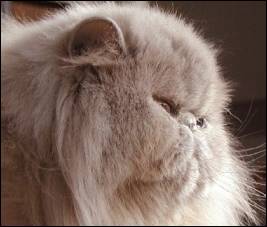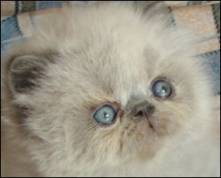|
Chrystele Bourely, Chocoland cattery
breeding Solid, Bicolor, Van, Himalayan, specializing in chocolate
and lilac varieties. Read more about how her interest in chocolates
began.
When did your love for these colors begin?
 It
began in 1996 when I bought my first chocolate persian girl
(Myléna de la Marjolaine, from Ch. Julien Van de Zuring
-- chocolate and white boy and Isis de la Marjolaine -- chocolate
girl) in France (European lines, mostly from Holland) I started
my breeding with silvers. I came to the French breeder with
the wish to buy a new silver shaded kitten but I fell in love
at first sight with the chocolate colour and purrsonality! She
was meowing with her tongue out her mouth. I was amazed by her
colour and her personality that I couldn't go away without taking
her with me. It
began in 1996 when I bought my first chocolate persian girl
(Myléna de la Marjolaine, from Ch. Julien Van de Zuring
-- chocolate and white boy and Isis de la Marjolaine -- chocolate
girl) in France (European lines, mostly from Holland) I started
my breeding with silvers. I came to the French breeder with
the wish to buy a new silver shaded kitten but I fell in love
at first sight with the chocolate colour and purrsonality! She
was meowing with her tongue out her mouth. I was amazed by her
colour and her personality that I couldn't go away without taking
her with me.
2 years after, I stopped the silver breeding to focus on the
chocolate and lilac colours also at a time when all the French
breeders was trying to discourage me to breed these rare and
difficult colours. I've been told that chocolate was bad black
and that lilac was only a pale blue.
Do you have a mentor, if so who?
I give credit to Alexandra Reynaud (Oceanicor Cattery), that
gave me the motivation to start showing my cats. In 1999, I
begun showing (before I only visited French cat shows, never
shown my own cats) my chocolate point girl, Assaja Juki. I came
back home with many ribbons :-) It was a very exciting cat show
for me ! Assaja did 2 BIS and was 5 best pointed cat at this
show.
 Do
you remember your very first chocolate/lilac brought into your
program? Do
you remember your very first chocolate/lilac brought into your
program?
Myléna has been my first persian girl, mother to many
litters. Without her, I'd never had kittens in that period (my
silvers was not good to breed with). She gave me my first lilac
kitten in 1998 -- a boy kitten from a inbreed mating, pet-breeder
quality but with a very pale lilac colour.
In 1998, Ch. CFA Degentilly Star, chocolate boy, imported from
Canada, has given me my first chocolate and lilac kittens of
show quality (mated to Assaja). It was the really first step
to my chocolate breeding program.
Do you have a favorite color division?
(bi-color, himalayan, solid, parti-color, smoke, tabby)
My favorite is solid and bi-color persian, but I like chocolate
and lilac colours in all the division!
Do you have any particular favorite
cats in your program?
Yes ... my particular favorite cat is my International Champion
homebred Choco'land Rare Beauty. She has a good cobby body that
is so difficult to get in this colour, very nice type (a deep
break, good doming, tiny ears) but a closed look. That is the
point I'd like to improve by mating her to a type boy with a
sweet look (BIG eyes!). She is also so loving and she loves
to be showing. She is the only one cat from my breeding that
can stay in the bath grooming without trying to escape!
 Since
all Himalayans are born white at birth, at what age do you determine
their color? Since
all Himalayans are born white at birth, at what age do you determine
their color?
At 15 days, I can see the difference between a blue or a lilac
point; a seal point and chocolate point. But even at the first
day, you can see a difference (that I'll check in the following
days) on the blue point kitten, you can see a more beige colour
body. On the lilac point, the body appears really white! So
with some practice, every breeder could see the difference at
the first day.
Do you have any advice when determining
a spoiled seal point from a chocolate point?
The body colour, the paw pad colour, the point colours and the
nose leather ... on a seal point, it is more dark (especially
when it's an adult, the body will turn out to loose the contrast
between the points and the body colour). On a chocolate point,
the body would be almost white and the nose would appear chocolate.
 Do
you have any advice when distinquishing a pale blue from a lilac
Persian? Do
you have any advice when distinquishing a pale blue from a lilac
Persian?
The difference is not easy on a bad lilac persian (dark) compared
to a very pale blue persian. But if the lilac has a good pale
colour, we can't make a mistake. The lilac persian has a pink-beige
colour, especially if you look closely in the coat. I use to
take off the long dead hair on my lilac persians. It's a good
way to groom the lilacs for the show & to show their true
colour. If a lilac persian is dirty and has not been well groomed
(dead hair taken off), the colour will not appear as it is.
It's like for a blue or for a black that would have white hairs
in their coat. On very pale lilacs you can see a pink nose leather.
But I've noticed that most of the lilacs will loose this colour
on their nose; it'll appear more dark, more beige than pink.
But when you've a blue persian (even if he is very pale) with
a lilac persian, side by side, front of you, you can't mix them!
It is really different colours. I've some pics to illustrate
it if you want.
At what age do you determine their
quality (pet,breed,show)?
At the day of birth, I can determine the kittens that are promising.
But I'll be able to determine their quality at 4 months old,
after their 2nd teeth and for the male when you can check their
testicles. For me, determining a show quality is to offer a
guarantee. I'd tell it with certitude only after a first showing,
not because I'd not be able to determine their quality but because
for me it's important to have the opinion of a judge: we never
know. We can have forgotten to check some important things,
like the tail, the teeth and so on. A show quality (or top show)
should be almost a "perfect" cat. A cat that should
win in most of the time on the show hall. It's important to
always be aware that we are not the only breeders. Looking at
other cats is the best way to always try to improve our breeding.
Some breeders will determine a cat as a show quality; for me,
he might be good for breeding only ... it's very subjective,
depending on what we mean as a show quality cat. When you've
seen many top show persians at the shows, you must be very strict
on your own kittens. It's like that, we'll improve our chocolate
and lilac persians: we can't anymore telling "they're nice
for a chocolate or a lilac persian! " We have to reach
the same quality as we can see in other colours. For sure, it's
a challenge ...
What is the most difficult part of
working with these colors?
Well, I'd first say that we always have to make hard decisions
: would I focus on the colour this year or would I focus on
the type? I've noticed that most of our chocolate or lilac persians
are from the same lines: European or US-Canadian (I could tell
you some more famous lines like Degentilly, Rosegarth, Tyland,
Foxy, Featherland, Kutzikoo ...). Now that we've gotten some
very nice subjects in those colours, we should stop mating only
chocolate to chocolate, to add new outcross lines. Like that
we'll stop getting faults (like jaw problems, kink tail, closed
lacrimal canal, yellow eyes ...). Inbreeding is interesting
to show the good and the bad things that are behind the cats.
After such matings we can be aware of what we've to improve
(or which cats we have to avoid from our program). So the most
difficult part is to get the colour, with improving the type:
first we have to add the colour to very good persians (no carriers);
then to make carrier matings to get both the type and the colour.
Or I could have said: first to make outcross by adding top show
quality persians to our chocolate or lilac persians. It's only
the way of thinking!
What is the most rewarding experience
working with these colors?
It's when you can show your homebred chocolate or lilac kittens
for the first time !!! But before that is when you get your
first chocolate or lilac show kittens!
What is your most important advice
about these colors you'd like to give?
Personnaly, I prefer the breeders who really came in the chocolate
breeding for the love for this rare colour. I'm always suspicious
with the breeders that came in it accidently (getting chocolate
kittens from unknown carriers) or with the new breeders that
want to buy a chocolate or a lilac kitten only because it's
the fashion colours ! I'd like to advice to be aware that breeding
chocolate and lilac persians can't be just because they're more
expensive ... or more rare. If new breeders want to start breeding
chocolate and lilac persians, it must be because they really
like those colours. Besides, to know that it takes time ...
and a lot of work! Improving, with love would be my main advice!
Is working with these colors for everyone? Do you have any
advice to offer anyone just starting with these colors?
Well, it depends on what we're looking for. . . breeding chocolate
and lilac kittens, or trying to improve them?! I'd suggest to
visit many cat shows ... to "make our eyes" on solid
or bicolor persians and himalayans. Than to look at the chocolate
and lilac persians and himalayans to be aware of what needs
improving. Breeders can start with those colours (like I did)
but they should learn to make outcross. And to never forget
that each year is a new challenge. You can't start by thinking
you'll only have to buy 2 chocolate or lilac kittens and that
you'll get show quality kittens in those colours. Maybe you'll
get, but you'll not get any reward for yourself by acting like
that. Everybody can buy 2 chocolate persians (if we are rich
enough!) but breeding is not only mating 2 cats. For me, it
means something else. Studying the pedigrees, learning at the
shows, visiting the breedings, making errors, trying many ways
of breeding, taking hard decisions, keeping many kittens ...
before improving our own cats. It can take many many years !
But it's worth the wait :-)
|

